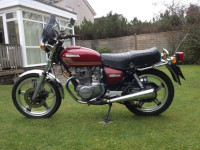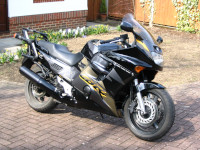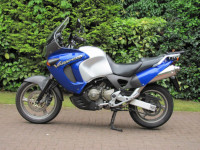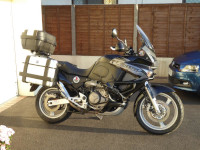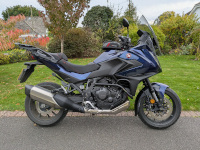My Bikes
It was May 2020 and I was stuck in COVID-19 lockdown looking for something to do? So I thought I would go through the bikes I've had over the years. Currently, I've had 14 of them, mostly Hondas with a Lambretta, a BMW and a couple of Yamahas thrown in. Below, the KMiles column shows how many miles I did on each of them. (I had to estimate the mileage for the first 5 of them.) As of 2025, my total mileage done on a bike is around 300K miles.
Bike Stats
Bikes
These are the bikes I've owned over the years. Probably not the most exciting line up you'll ever come across but there were no lemons amongst them and they've given me a lot of pleasure. I've done a few rallies on them and toured all over the UK and Europe on them.
Lambretta LI150

Back in 1972 I paid £50 for a 6 year old Cornish Lambretta. My only 2-stroke with a squirt of oil needed at every fill up! I had been given the choice of a holiday to Italy with my Mum and Stepdad or the Lambretta. I chose the Lambretta! There were no CBTs back in those days. I don't think I even had to wear a crash helmet when I started? How times have changed. I picked up the Lambretta complete with L plates from Plymouth's version of Del Boy. My only instruction from him before setting forth was to never hold the clutch half on. With this golden nugget delivered to me off I tottered on the Lambretta. Zero experience and training coupled with the Lambretta's little wheels and awful drum brakes meant that I had a quite few low speed offs. Those brakes! I nearly ran over the examiner on my test when he suddenly sprung out in front of me for an emergency stop. However, I learnt a lot and there was no more need to take the bus to school. It could be temperamental when hot but it always kept going. I even hand painted it blue. I had it for around 3 years eventually passing it on to my brother.
Honda CD175

In 1975 I was between my 2nd and 3rd year at university when I managed to earn enough money over the summer to trade up to a second hand CD175. After the Lambretta it felt like I had graduated to a real motorcycle. My first big trip on it was to ride from Plymouth to Hull where I was at university. I took the Fosse Way and the only problem I encountered was my number plate falling off at Banbury. I also remember a camping trip to the Ilse of Wight with a mate who also had a CD175. It was a very reliable little bike which was largely responsible for my Honda brand bias.
Honda 400 Four CB400F

It was 1977 and after finishing university and starting work, I bought myself (on hire purchase) a little legend, a second hand red 400-Four. My mate had traded up his CD175 for a nice blue 400-Four and I was jealous. It was a bit different to the one shown in the stock photo with its white cockpit fairing and drop-down ace bars. Looking back it was a physically small bike that my gangly 6'1" frame didn't best suit. However, my girlfriend and I went all over England on that bike venturing as far afield as Cumbria. We also went on honeymoon to North Devon on it. (It snowed in April in those days and working class people didn't get married in the Maldives.) I loved riding that bike but it wasn't without its flaws. The ignition suffered in wet weather and my girlfriend never appreciated the rear foot pegs being mounted on the swing arm.
Honda Dream 400T
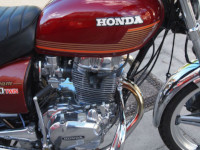
In 1978 I sold the 400-Four and, with a steady income, bought myself a brand new Honda Dream CB400T. It was one of the first mass manufactured bikes to come with cast wheels (as opposed to spoked wheels). Honda called them comstar wheels. It wasn't a popular bike but I liked it and, controversially, thought it was a better bike than the 400-Four. With its balancer shafts to counteract vibration and a wide seat it was very comfortable to ride. Unlike the 400-Four, there was no need to "ring its neck" to get it to perform. It was our only form of transport. I still remember my wife and I riding it to the first house we bought and arriving soaked to the skin. We did some touring around England on it. I remember a holiday in the Yorkshire Dales when it was so wet and cold that we spent much of our time inside with a log fire watching Wimbledon. (This was before global warming.) In 1982 my work situation meant that I wasn't using it much and I passed it on to my brother.
Honda CB750F2

After two kids and around 10 years of motorcycling abstinence, in 1993 I bought myself a second hand CB750F2. It was a bike that did everything asked of it but it was never going to set the world on fire. The engine had self-adjusting hydraulic valves that made maintenance very easy. What happened to self-adjusting hydraulic valves? I didn't do any long distance rides on this bike I used it for my daily commute to work and rides with the local IAM group I trained with.
Yamaha XJR1200

Up to this point my only departure from the Honda brand had been the little Lambretta I had started with. But ... unable to resist a bright red muscle bike, in 1996 I bought a grey import Yamaha XJR1200. Unfortunately after only 6,000 miles I wrote it off. On a cold and sleety January day I high-sided it at 70 mph on a local dual carriageway. I slid down road the for what seemed forever coming to an abrupt stop when a muddy bank got in the way. The bike flipped over and eventually came to a stop leaning against a tree by the side of the road. A passing biker thought I had just pulled over and waved to me as he rode past. Unfortunately, the damage to the bike was extensive and it was written off by my insurer. Fortunately, I walked away with just bruises to my body and ego. I never did really understand what happened that day. I know I shouldn't make excuses but ... the original XJR1200 tyres were not confidence inspiring and I'm sure the shiny patch of worn road my bike went over played its part. I passed my IAM advanced test on that bike as well!
BMW K100RT

My off on the XJR1200 didn't do a lot for my confidence so I decided to take on a project in the form of an unloved 1985 K100RT. Why a K100RT? There was one available. It was cheap. Owing to the longevity of the K100 series it was easy to get parts for it. It was easy to work on largely because it employed long established BMW car technology. Unusually, the K100's engine is mounted longitudinally, flat across the frame with the valves on the left and the crankshaft on the right. It's also shaft driven and was the only shaft driven bike I've owned. I stripped down the K100RT and had its bodywork repaired and re-sprayed. The seat was reupholstered and a lot renewed including windshield, main stand, tyres and battery. After a full service it was ready to go. Its engine developed 90 HP and I found it to be a bike you could hustle along on when needed. It also provided excellent weather protection. Of course, it was never going to be a head turner. I became quite fond of it but in the end its age told on it and I was doing a lot of repairs to it including the alternator, rear shock absorber, gear box, etc. Like a car, it had a dry clutch with the gear box being a separate self-contained unit so changing it wasn't too fraught.
Honda Big One CB1000FS

It was 1999 and I fancied a VFR750F a car dealer had in his Poole showroom. Unfortunately we couldn't agree a price but I guess things turned out for the best as I ended buying a CB1000FS "Big One" muscle bike instead. I bought it in a private sale from a guy at Frome. It was 3 years old, had done just over 3000 miles and was in excellent condition. I have no regrets about the VFR750F. I still have the CB1000FS. It's done 54K miles now. New, the CB1000FS was a bit more expensive than its competitors of the time, Yamaha's XJR1300 and Kawasaki's ZRX1100, so Honda didn't sell a lot in the UK. But it oozes Honda quality and I got it for a bargain price. I did many rallies on it and even did a little bit of European touring. Some things I don't like about it? I don't like its size 18" rear wheel because it limits tyre choice. I also don't like its deeply recessed cam chain tensioner (CCT) as all CB1000FS eventually develop the infamous Honda cam chain rattle and it's a devil to get at the CCT. Other than that, it's a lovely bike to work on and ride. With three bikes I was finding that the CB1000FS spent most of its time in the garage so in 2025 I sold it. I had owned it for 26 years and was very sad to see it go but it went someone who I think will do right by it.
Honda CB1000FV

In 2002 I was looking to swap the K100RT for a newer touring bike. I ended up buying a CBR1000FV kitted out with Givi touring gear in a private sale from a guy at Abingdon. With its "jelly mould" fairing, it had a lot in common with the CB1000FS I already had. It basically had the same engine but tuned to develop more power. My wife and I did several rallies on it and we took a trip to the Nurburgring on it where I completed a solitary lap owing to the carnage on the track that day. It was a capable bike but I never managed to fully eliminate its tendency to wobble the handlebars and because of that it wasn't a bike I really felt totally comfortable on.
Honda Super Blackbird CBR1100XX5

It was in 2005 that I traded up my CBR1000FV for a new Super Blackbird. The first production bike to clock 300 KPH and the quickest bike around in the 90s. I had always wanted one and it's my most powerful bike (I still have it). A lovely bike with a tendency to destroy rear tyres if you're none too gentle with the throttle. I kitted it out with Givi touring gear and we started touring Europe on a regular basis riding to Italy, France and Spain. The bike has also been around the top of Scotland a few times. Scotland, just north of Inveraray, was where I once had a minor prang on it which resulted in a 11 hour recovery back to Dorset and a new front cone. As of 2025, the Blackbird has 74K miles on its clock. It would have been more miles if not for its regulator/rectifier and stator problems (Blackbird weak spot). At one stage it was going through stators at a rate of one per 1000 ~miles. At the end of 2024 I fitted it with an expensive Shindengen SH847 regulator/rectifier sourced from Calfornia. Touch wood, this seems to have cured the electrics problems. It's still my favorite bike to ride. Smooth and powerful abeit the riding position is a bit hard on my old frame.
Honda Varadero XL1000V2

How did I end up with a Varadero you may ask? Nobody loved the Varadero. Well I always wanted to do the Stella Alpina rally and it looked like it might do off-road? In a private sale in 2011 I bought a 9 year old unloved Varadero XL1000V2 from a policeman at Newbury. This was a few weeks before the rally was due to be held. It was a very heavy physically large bike. The front discs were warped and it needed a thorough service before the rally. (I wish I had changed the brake fluid as the rear brake over heated and became unresponsive whilst descending a steep alpine hill.) It was a capable long legged touring bike with a very smooth engine. However, it required some considerable effort to get it up the 3009 metres of Stella Alpina. It definitely wasn't an off-road bike but I'm pleased to say I managed not to drop it. However, it didn't last. A Dorset farmer caused me to fall off it when he covered the A road outside his farm with a 100 metres of extremely slippery liquid slurry one dark night. I was going slowly but there was damage to the bike's right side as it slid down the road. I just smelt really bad. It had even more character after that as all I could find on ebay was an orange left panel to go with the blue. As well as the Stella Alpina, I toured Ireland on this bike. An underrated bike that served me well but it was a bit top heavy and could be very thirsty if pressed.
Honda Varadero XL1000VAB

I was so taken with the Varadero that in 2014 I bought another one. A new XL1000VAB from Dobles that was going cheap because lucky for me everyone wanted a GS. It was made in 2011 and one of the last Varaderos ever made so I guess Dobles had had it a while. It improved over my previous Varadero in that it was fuel-injected and had an extra sixth gear to make it less thirsty. It also had ABS brakes and the styling had changed but in all other respects it was very similar. It improved over my old Varadero but somehow it seemed to lack the old Varadero's character? However, it was an extremely reliable bike that when kitted out with Givi gear took me all over Europe, as far afield as Romania and the Baltic states. Unfortunately after dropping it a few times I got fed up with how heavy it was. With the weight high up it meant that a slight deviation from the vertical when maneuvering it around could leave it ending up on the deck. The Givi engine bars were invaluable in that respect although they did have a bit of Hammerite paint on them by the end. All-in-all, a great touring bike that enabled me to go places in the confidence that it would get me there and back. My view is why would anyone pay the extra money for a GS?
Yamaha Tracer 900 GT MTT850D

So I like the Honda brand but I couldn't see much that captured my imagination in Honda's line-up for 2020? Maybe the Africa Twin but the CRF1000L has tubed tyres and the CRF1100L with its tubeless tyres was a bit expensive for me. Looking around I saw a few options. I really like the Ténéré 700 but I was really looking for a touring bike and it also has tubed tyres. Eventually it occurred to me that the Tracer 900 GT was what I was looking for. A light weight ready-to-go tourer that could be had at a reasonable price. It even came with a centre stand! So I took the plunge and bought one in March 2020. The Tracer served me well taking me on two very enjoyable long distance European tours, one through central Europe and the other south Eastern France. The Tracer proved itself to be very good sports-tourer with the emphasis on sports. The tripple engine is one of the best and the bike handled well. The only slight downside was the transmission. The gearbox could be clunky and I never quite managed to eliminate a final drive whine despite changing the sprockets and drive chain. The Tracer also had a tendency to 'die' a bit when pulling away. I experimented with clutch release, engine revs and ride modes but I never quite managed to sort it?
Honda 1100A

I achieved the grand old age of 70 in 2025 but I still wasn't ready to give up on motorcycling so I traded in the Tracer for a Honda NT1100A. The A suffix means that the bike has a manual gear change. There's also a NT1100DCT which has an automatic gearbox. Being old school I wanted a manual geabox. I had had my eye on the Honda NT1100 and was waiting for its facelift in 2025 when the SC88 version replaced the SC84 version. The main improvements in the SC88 model over the SC84 model were sharper styling (integral front indicators instead of stalks), easier screen height adjustment, an appreciable increase in torque and a new six-axis Inertial Measurements Unit to help the electronics do a better job at traction control and ABS. The NT1100 is a well equipped tourer coming with large panniers (and liners), a centre stand, heated grips and cruise control. I've added a few extras to that including crash bars, radiator guard, fender extender, rear rack, tank bag and most importantly, a Puig windscreen. For me, the standard windscreen was awful. The bike is very capable but I must say Honda don't make it easy for a home mechanic such as myself to work on it. I guess this is the modern trend for all manufacturers?



